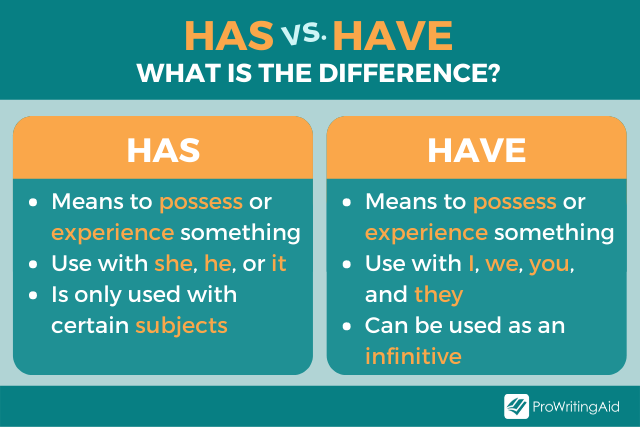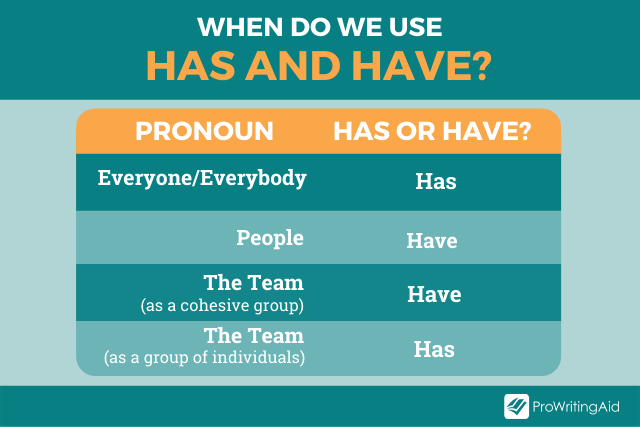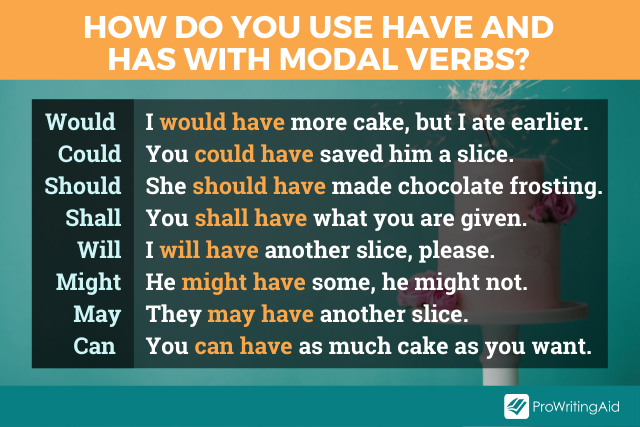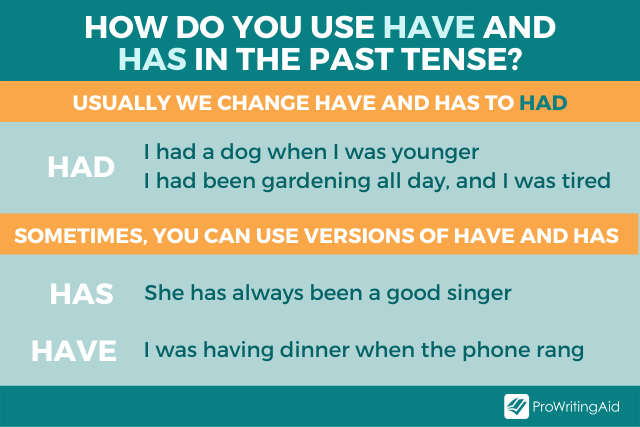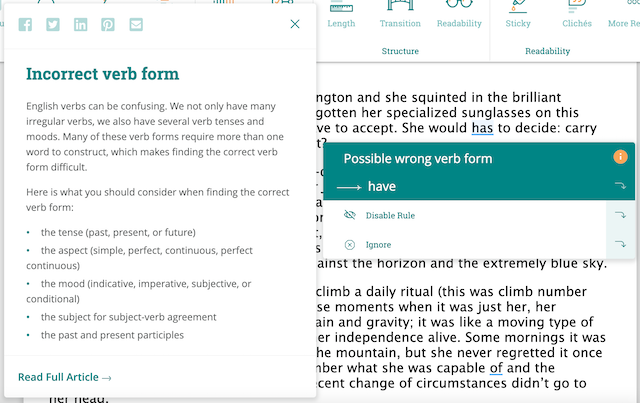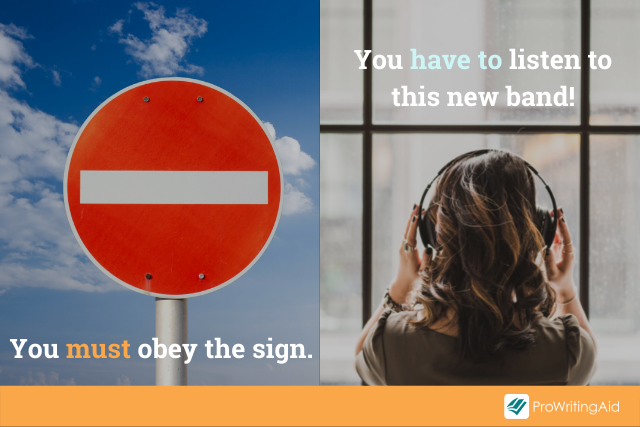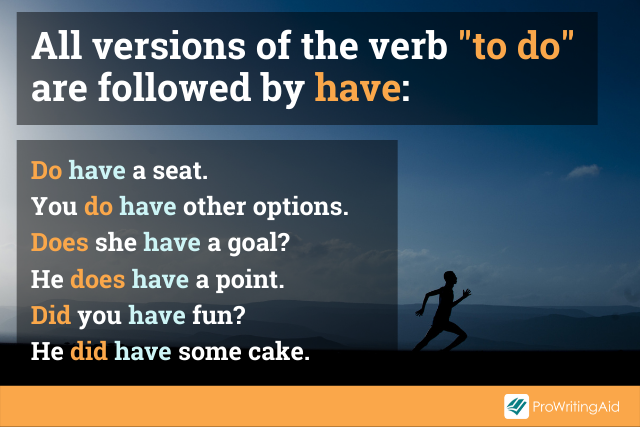You probably use has and have often, but do you know the grammar rules behind how you use them?
Take this pair of sentences: which one is correct?
Is it, “Peter have a dog” or “Peter has a dog”?
If you’re not using a third person pronoun, like he, she, or it, or a name, you can almost always use «have.» Keep reading for the exceptions.
We’ll use the tips in this article to find out the answer and learn when to use has vs. have.
What Is the Difference Between Have and Has?
The words «has» and «have» both come from the verb «to have.»
To have means to possess or hold something. It also means to experience or undergo something. «Has» and «have» both mean the same thing as «to have.»
So why are there two different versions of the word?
When Should I Use Have or Has?
It’s all to do with who we are talking about. Whether you use have or has depends on the point of view you are using. Luckily, you only use has when talking in the third-person singular (that’s grammar jargon for using he, she, or it in a sentence).
If you’re not using he, she, or it, you can almost always use «have.» Keep reading for the exceptions.
First, let’s look at some examples of when to use has and have.
When Do I Use Have?
We use have when talking about ourselves in the first person perspective (using I), when addressing someone else directly in the second person perspective (using you), or when referring to multiple people in the third person plural (using they).
Here are some examples:
- I have a dog.
- You have a cat.
- They have horses.
In all three of the examples above, have is used to indicate ownership.
Now take a look at these:
- I have seen that movie.
- You have been there, right?
- They have worked hard on this project.
In these examples, have is used to show that the subject of the sentence (I, you, they) has been through an experience (seeing the movie, going to a place, working on a project).
To recap: If you’re using I, we, you, or they, use have.
When Do I Use Has?
We use has when talking about someone or something else in the third person singular. That means that if you’re referring to just one person or thing, and you’re not using «I» or «you» to refer to them, you need to use has.
Here are some examples:
- She has red hair.
- He has eight siblings.
- It has many special features.
As before, in all of those examples has indicates ownership.
Now take a look at these:
- She has been to school.
- He has learned how to crochet.
- It has fallen over.
In these examples, has shows that the subject (she, he, or it) have experienced something (been to school) or undergone a change (learned to crochet, fallen over).
Are Has and Have Singular or Plural?
So, to recap:
- Have can be singular (I / you have) or plural (we / they have)
- Has is always singular (he / she / it has)
Seems simple, right? However, this can get tricky when you’re talking about a group of people, a team, or a company.
If you’re referring to a group of people with the pronoun everyone or everybody, you need to use has:
- Everybody has bad days.
- Now that everyone has a booklet, we’ll get started.
But if you’re referring to a general group such as children, people, and the media, you’ll need have:
- Children have struggled during the pandemic.
- It’s hard to tell if people have strong feelings on the subject.
- The media have made the issue worse by causing panic.
Is It «The Team Has» or «The Team Have»?
If you’re using a collective term, like family, team, company, or group, you can use has or have. This is because we can view these terms as one single group, or as a collection of individuals.
- The team has achieved record results this year. (team = single group)
- The team have achieved record results this year. (team = collection of individuals)
Do I Use Has or Have with a Name?
When you refer to an individual by name, you’re using the third person singular—that means you use has.
That’s because names take the place of «he» or «she» (or any other singular pronoun, like the non-binary pronoun, «they») in a sentence.
- He has a dog.
- Peter has a dog.
Now we have the answer to our earlier question. It’s Peter has a dog, not Peter have a dog.
Is It «She Should Have» or «She Should Has»?
It’s she should have. Even though we are using she, which usually goes with has, the verb should has special rules.
That’s because it’s a modal verb. We won’t get into those here, but you should know that if you always use have after a modal verb.
Here are the verbs to look out for:
- Would: I would have gone, but I was held up at work.
- Could: You could have saved him.
- Should: She should have asked me before she sold my bike.
- Shall: You shall have what you are given.
- Will: I will have the risotto, please.
- Might: He might have told me; I can’t remember.
- May: They may have been right about that.
- Can: You can have whatever you want.
What Tense Are Have and Has?
We can use the words have and has to make a few different tenses. This can get a bit complicated, but we’ll start simple.
If you are speaking about someone owning something in the present tense, you’ll use have or has with the same rules as before:
- She has an ice cream.
- I have tickets to the concert.
- They have coconut cream pie on the menu.
This is known as the simple present tense.
If you want to say that someone owned something in the past (but not necessarily now), use had. Had is the past tense version of have/has:
- He had lots of jewellery.
- You had an olive tree at the old house.
- They had excellent WiFi at the hotel.
This is known as the simple past tense.
You can also use has, have, and had to create more complex tenses.
If you want to refer to something that started in the past and continues into the present, use have or has with the same rules as before plus an -ing verb:
- She has always loved running.
- I have been going to ballet class since I was five.
When Do You Use «Was Having» or «Had Been Having»?
If someone began owning or experiencing something in the past, and this was still happening when another event occurred, use was / were having, like this:
- I was having breakfast when he got home.
- John was having a nightmare when he woke up.
- Don’t blame yourself. You were having a terrible time at work already when it happened.
If you want to describe a continuing experience that occurred before a particular time in the past, use had been having:
- I had been having trouble with my car already when I set off on the journey.
Is It Grammatically Correct to Write «Had Had»?
If you or someone else finished doing something before a specific point, you’ll need to use «had» before the action:
- No wonder you’re hungry. You had finished your lunch before 10am!
- I had seen over 50 horror films by the time I was 13.
- She had run a marathon before, but never as fast as she did this time.
This can look a bit weird if you want to say that you or someone else had finished owning or experiencing something before a point:
- They had had their dinner by 7pm.
- You had had that blanket for years before you lost it.
- I had had my prom dress ready for months before the event.
In all of these examples, it is correct to say «had had.»
If you’re worried about using have and has in your sentence, try ProWritingAid. It works anywhere you write, and will let you know if you’ve used the wrong word:
Sign up for a free ProWritingAid account and start writing like a pro.
What Is the Difference Between Have, Has, and Must?
On their own, have and has don’t mean the same thing as must.
However, the phrases have to or has to do mean the same thing as must. You can use have to / has to and must interchangeably, however sometimes must is more compelling.
- You have to do your homework before you go to the skate park.
- You must do your homework before you go to the skate park.
While these sentences technically mean the same thing, using must in the second example sets a more commanding tone—the speaker is telling the listener what they must do.
Here are some more examples of have to and has to in a sentence:
- I have to leave for work by eight.
- You have to listen to this new band!
- She has to learn her lines for the performance.
- Children have to be accompanied by an adult to ride the rollercoaster.
- The Government has to resolve the issue by the end of the week.
- It has to stop raining before we can play football.
Can I Use Have and Has in the Same Sentence?
Yes, of course! Just use the same rules we’ve already covered.
For example:
- She has red shoes, but I have blue shoes.
- He has seen movies that have not been released yet.
You might also use the phrase «has to have» in your sentence to mean «must have»:
- She has to have the correct uniform to attend school.
- Jane is a perfectionist. She has to have everything planned down to the last detail.
What Is the Difference Between Hasn’t and Haven’t?
Hasn’t and haven’t are negative contractions of has and have. They mean «has not» and «have not» respectively.
When you use hasn’t or haven’t, it is usually to say that you have not experienced or undergone something, rather than to say that you do not own something.
Use hasn’t and haven’t with the same rules we covered before. Hasn’t goes with she / he / it and haven’t goes with I / we / you / they.
- We haven’t got any potatoes left in stock.
- The shop hasn’t got any potatoes left in stock.
- I haven’t been able to get any potatoes.
- How will you cook the dish if you haven’t got any potatoes?
Remember, if you can replace the subject of the sentence (the thing doing the having or not having) with it, use hasn’t—like with «the shop» in the example above.
What Are Some Examples of Has or Have in a Sentence?
Let’s finish up with a quick-fire round of some common phrases that use has or have.
Is It «Does Have» or «Does Has»?
It’s does have. This is because the verb to do (which turns into does, did, etc.) requires you to use the root form of any verb you put after it.
This sounds confusing, but all it means is that you need to use «have» after any version of the word «do» :
- Your plan does have its benefits.
- He does have a point.
Is It «Did It Have» or «Did It Has»?
This follows the same pattern as above. «Did» is the past tense version of the word «do,» so the answer is did it have.
- Did it have to end this way?
- Did she have a haircut?
- Did the hotel have a swimming pool?
Is It «Someone Have» or «Someone Has»?
Someone is a singular pronoun, like he or she. That means that, in most cases, we use has.
- Someone has poisoned the waterhole!
However, if you’re asking a question beginning with «Does,» you need to use have, as above:
- Does someone have time to help me with this?
Is It «Which Have» or «Which Has»?
This depends on the subject of your sentence. Remember, we only use «which» with non-human subjects.
If it is a singular subject, use which has. If it is a plural subject, use which have.
- Plural: Watches, which have always been used to tell the time, now have many other purposes.
- Singular: The bandstand, which has been standing for 100 years, is being demolished this Saturday.
Have You Got It?
Now you know how to use have and has in your sentences. Remember, before you decide which one to use, check your tense and who you’re talking about.
Take your writing to the next level:
20 Editing Tips from Professional Writers
Whether you are writing a novel, essay, article, or email, good writing is an essential part of communicating your ideas.
This guide contains the 20 most important writing tips and techniques from a wide range of professional writers.
Have and has are different forms of the verb to have. Even though they come from the same word, there are slight differences in the way they’re used.
While the verb to have has many different meanings, its primary meaning is “to possess, own, hold for use, or contain.” Have and has indicate possession in the present tense (describing events that are currently happening).
Have is used with the pronouns I, you, we, and they, while has is used with he, she, and it.
How do you use have?
Have is the conjugation of to have that’s used when:
- speaking in the first person (I, we)
- speaking in the second person (you)
- speaking in the third person plural (they)
Take, for example, the following sentence: “They have two dogs.” Here, have is the correct choice because the subject (they) is a third person plural pronoun.
How do you use has?
Has is the conjugation of to have that’s used when:
- speaking in the third person singular (he, she, and it).
This example from And the Mountains Echoed by Khaled Hosseini shows has used with a third person singular pronoun (he): “He has a slender nose, a narrow mouth, and tight blond curls.”
As noted, this use of have and has only really applies when you’re speaking in the present tense.
How do you use have and has with other verbs?
Indicating possibility
Now that you’ve mastered the basics of have and has, it’s time to talk about how to use them in combination with other verbs. For every sentence that simply indicates possession (I have a cat), there’s going to be another that uses to have in a more complex way. For example, if you say I have to groom the cat, that’s definitely more complicated of an issue … in more ways than one!
One way have and has combine with other verbs is to describe what could happen (but hasn’t yet):
- You have to call me tonight.
- He has to do his homework before dinner.
These actions have not occurred yet. As before, have is used with the pronouns I, you, we, and they, while has is used with he, she, and it.
Indicating completed action
Have or has can be used to communicate that the action of a verb was completed prior to the present. To do that, you will create what’s called the present perfect tense, which involves more complex time relationships, and combines a verb with has, have, or had:
- We have waited for hours in this line.
- You have finished the job on time.
- She has learned an important lesson.
In the sentence “She has played banjo for four years,” for example, has is an auxiliary verb (a helping verb used in the construction of verb forms), and played is a past participle. As in the examples mentioned before, has is used with a third person singular pronoun.
Get that essay, email, or letter to Nana over the finish line with a little writing help from Grammar Coach™. Get grammar check, spelling help and more free!
This is complex stuff, so don’t feel bad for not memorizing all of these rules. What’s important to remember is that together, has and a past participle like played form the present perfect tense.
Another example of the present perfect tense is seen in this sentence from The Night Circus by Erin Morgenstern: “‘I have invited you all here for a reason,’ Chandresh says, ‘as I’m sure you have surmised by now.’”
In the first part of the sentence, have is used because there is a first person subject (I). In the second part of the sentence, have is used again because there is a second person subject (you).
Here’s a recap
Have is used with the pronouns I, you, we, and they. Has is used with he, she, and it.
- Have and has can indicate possession.
- Have and has can combine with other verbs to indicate more complex relationships with time.
Want to possess an even better grasp on grammar? Then you have to check out this article on the difference between who and whom.
«Have» and «has» are both present tense conjugations of the verb «to have,» and we use «have» or «has» depending on the subject.
If the subject is 3rd person, singular, then you use «has.» All other subjects take on «have». See below:
Singular
3rd Person He/She/It HAS
Plural
1st Person We
have
2nd Person You
have
3rd Person They
have
Ex.
She has a doctor’s appointment tomorrow.
They have a long day ahead of them.
My dog has a good temperament.
We both have an iPhone.
My sister has a hybrid car.
Remember that the verb «to have» serves two purposes in the English language:
- Verb: Of course, as you know, the verb «to have» is used to express possession, as in the examples above and as in «I have a dog, a house and a beautiful family.»
- Auxiliary Verb: «Have» is also used as an auxiliary (or helping) verb when using the present perfect. (Click here to learn more about the present perfect.) See below for the grammar construction of the present perfect:
Present Perfect Grammar:
When using the present perfect, we conjugate the verb «to have» in the same way as the present tense as seen above; that is, the 3rd person singular changes to «has.»
I/You/We/They + HAVE + past participle
He/She/It + HAS + past participle
Ex.
I
have traveled
to Paris three times.
He
has
never
seen
a James Bond movie!
They
have taken
the test.
We
have
just
finished
writing the report.
My dog
has
already
gone
for a walk four times today.
They
have taken
the test.

By
Last updated:
December 15, 2022
As an English learner, you probably see the English words “has” and “have” frequently.
If you’re a beginner English speaker, you might be confused about how to use them. In that case, you’ve come to the right post.
We’re going to crack the code and solve the mystery of “has” vs. “have.”
Contents
- What Are “Has” and “Have”?
-
- “Has” and “Have” to Mean Possession
- “Has” and “Have” as Auxiliary Verbs
- “Has” vs. “Have”: What’s the Difference?
-
- Points of View in English
- “Has” vs. “Have” in the Present Tense
-
- Using “Has” in the Present Tense
- Using “Have” in the Present Tense
- “Has” vs. “Have” in the Present Perfect Tense
-
- Using “Has” in the Present Perfect Tense
- Using “Have” in the Present Perfect Tense
- Summary: “Has” vs. “Have”
- How to Practice “Has” and “Have”
Download:
This blog post is available as a convenient and portable PDF that you
can take anywhere.
Click here to get a copy. (Download)
What Are “Has” and “Have”?
“Has” and “have” are both verbs.
Verbs are used to indicate action. Along with nouns, adjectives, pronouns and prepositions, they’re one of the basic parts of speech in English.
“Has” and “Have” to Mean Possession
When we talk about possessing (owning) something, we use the verb “to have.”
“To have” is the infinitive, or original, form of the verb.
Here are some conjugations of the verb “to have”:
| Tense | Conjugation |
|---|---|
| Present | has, have |
| Present progressive | is / are having |
| Past | had |
“Has” and “have” are both conjugations in the English present tense.
For example, look at the following sentences:
She has the book.
I have the book.
In both sentences, the verb “to have” is conjugated in the present tense.
“Has” and “Have” as Auxiliary Verbs
The verb “to have” has another use. It’s also an auxiliary verb.
An auxiliary verb is combined with another verb to complete the meaning of a sentence. Because of this, it’s also called a helping verb. For example:
She has eaten dinner already.
I have seen that movie.
These sentences both use the perfect tense. Here, “has” and “have” don’t indicate possession. Instead, adding “has” or “have” to another verb creates that verb’s perfect tense form.
In general, the verb “to have” is important as an auxiliary verb because it creates the past perfect and present perfect tenses for other verbs.
“Has” vs. “Have”: What’s the Difference?
Really, the difference between “has” and “have” is all about English points of view:
Points of View in English
In English, anything we read or speak is coming from a particular point of view. The point of view tells you who is speaking, and who is being spoken about.
You can know the point of view by looking at which pronouns are used. Let’s quickly review:
| Point of View | Meaning | Singular Pronoun | Plural Pronoun |
|---|---|---|---|
| First Person | The speaker is talking about himself or herself (with other people included if plural). | I | We |
| Second Person | The speaker is talking directly to somebody else. | You | You |
| Third Person | The speaker is talking about somebody or something else. | He (men) She (women) It (non-living things) |
They (people or things) |
Got it? Great! Now that you understand points of view, using “has” and “have” becomes very easy.
“Has” vs. “Have” in the Present Tense
“Has” and “have” can both be used in the present tense as a main verb to mean possession.
Here’s the difference:
| Type of Sentence | Has | Have |
|---|---|---|
| Affirmative Statement | ✓ (he, she, it, singular nouns) | ✓ (I, we, you, plural nouns) |
| Negative Statement | 𐄂 | ✓ |
| Question | 𐄂 | ✓ |
Using “Has” in the Present Tense
There are two points you have to remember:
1. In the present tense, “has” is used with the third-person singular point of view.
That means you’ll use it with “he,” “she,” “it,” a name or a singular noun.
It’s also used with singular pronouns like “everybody,” “anybody,” or “nobody”:
Everybody has a copy of the book.
Nobody has the answer.
I don’t think anybody has coffee.
2. “Has” is only used with affirmative (non-negative) statements.
If you’re asking a question or if you’re talking in the negative (using the word “not”), you won’t use “has.”
He has brown eyes.
She has the answer to your question.
That book has 400 pages.
Japan has amazing food.
Meena has 45 pencils.
Using “Have” in the Present Tense
1. In the present tense, use “have” in the first- and second-person points of view, and in the third-person plural point of view.
In other words, use “have” with the subjects “I,” “you,” “we” or “they”:
I have a headache.
You have a new laptop.
They have three cats.
We have a big house.
Also, use “have” with plural nouns or when talking about multiple people or things at the same time:
Those dresses have stripes.
Roger and I have a red car.
My dog and Patricia’s cat have brown fur.
2. If you’re asking a question or making a negative statement, then always use “have,” regardless of the point of view.
Here are some questions in the present tense, all using “have”:
Does anybody have the answer to the question?
Do you have the book?
Does she have a house?
Does Meena have a best friend?
Do I have your attention?
The same is true for negative statements in the present tense:
She does not have a room.
I do not have a brother.
They do not have time to see you.
The movie does not have a good plot.
We do not have a dog.
To repeat: with a negative statement or a question, use “have” even if the subject is “he,” “she,” “it,” a name or a singular noun.
“Has” vs. “Have” in the Present Perfect Tense
“Has” and “have” can also be auxiliary verbs that help create the present perfect tense, in combination with other verbs.
The rules for using them as auxiliary verbs are actually simpler. It just depends on the subject:
| Subject | Has | Have |
|---|---|---|
| Pronoun | He, she, it | I, you, we, they |
| Noun | Singular | Plural |
Using “Has” in the Present Perfect Tense
Whatever kind of statement you’re making, whether it’s an affirmative or negative statement or even a question, you’ll use “has” as long as the subject is third-person singular: “he,” “she,” “it,” a name or a singular noun.
John has gone to California four times. (Affirmative statement)
The dog has not eaten today. (Negative statement)
Has she received the letter? (Question)
Has he not told you about this? (Question)
Using “Have” in the Present Perfect Tense
Similarly, with “have,” you use it in the present perfect tense with subjects “I,” “you,” “we” or “they,” as well as plural nouns.
I have watched “Game of Thrones” four times.
You have helped me a lot.
They have asked many questions.
We have thought about this all day.
This is true for any kind of statement or question too:
My friends have not watched “Game of Thrones.” (Negative statement)
You have not helped me at all. (Negative statement)
Have they asked too many questions? (Question)
Have we thought about this enough? (Question)
Summary: “Has” vs. “Have”
Here’s a quick summary of what we’ve learned:
- “To have” is the verb associated with possession or ownership.
- “Have” and “has” are both conjugations of “to have” in the present tense.
- “Have” and “has” are also used as auxiliary (helping) verbs in the present perfect tense
In the present tense…
- Use “has” with the subjects “he,” “she,” “it,” a name or a singular noun.
- Use “have” with the subjects “I,” “you,” “they,” “we,” a plural noun or multiple subjects.
- But, use “have” for any questions or any negative statements—no matter the “point of view.”
In the present perfect tense…
- Use “has” any time you use the subjects “he,” “she,” “it,” a name or a singular noun.
- Use “have” any time you use the subjects “I,” “you,” “they,” “we,” a plural noun or multiple subjects.
How to Practice “Has” and “Have”
Practicing English grammar doesn’t need to be hard or boring. There are many amazing resources available on the internet, plus other fun ways to practice.
Take Online Quizzes
You can test your progress by taking free online quizzes.
If you’re curious as to whether you’ve understood the differences between “has” and “have,” try this quiz on EnglishGrammar and this one on EnglishExcercises.
For on-the-go practice, check out this worksheet from Study.com that you can download and print.
Watch Authentic Videos
Think of something you’re interested in, and find English videos about it.
Whether you want to watch vehicle rescues or follow American sports, there’s something out there for you.
Action-packed themes like these often describe people and their qualities/attributes, so you’ll be able to hear the difference between “has” and “have” quite frequently.
You could also use a virtual immersion platform.
FluentU, for example, has a large library of culturally relevant short videos for different learner levels, along with annotated subtitles. These can make it easier to notice the context that “has” and “have” are used in:
Immersing yourself in English helps you learn and remember grammar rules like the difference between “has” and “have.”
If you listen to enough English, you’ll be able to know which word to use just by knowing what “sounds right.”
Write from Multiple Points of View
If you’re keen to improve both your grammar and writing skills, try this writing exercise. Write a short paragraph about yourself. Be sure to use the verb “have” as many times as you can.
Then, rewrite the paragraph as though it’s about somebody else. As we’ll see below, this will force you to practice the difference between “has” and “have.”
As a warm-up exercise, you can also try changing the pronouns in the example sentences we’ve provided in this article. Once you’ve changed the pronouns, change the verb to match.
Now, it’s time to use these important words.
Study all the examples closely. Use “has” and “have” in your daily conversations, and don’t be afraid of making mistakes!
Download:
This blog post is available as a convenient and portable PDF that you
can take anywhere.
Click here to get a copy. (Download)
Has and have are different conjugations of the verb to have. Have has to do with possession, and to have something is to be in possession of it.
- I have a pencil.
Has and have sometimes get confused with each other in people’s writing–but more often in speech–because have is an irregular verb. It, therefore, doesn’t take the usual verb endings of other English verbs.
What is the Difference Between Has and Have?
In today’s post, I want to talk about when to use has and have, how each word works in a sentence, and how to make sure you don’t confuse them again.
The short answer when comparing has vs. have is that has is used with the third person singular. Have is used with the first and second person singular and plural and the third person plural.
If this sounds a bit confusing, or you don’t quite remember what differentiates the first, second, and third person, don’t worry. I will explain everything below.
After reading this post, you won’t ever again wonder to yourself, “Should I use has or have?”
When to Use Has

- He has a great idea.
- She has a car that we can borrow.
- The new iPhone is great; it has a bigger screen.
- John has a headache and doesn’t want to go out tonight.
- It’s not clear if the team has a policy prohibiting players from traveling when they are out with an injury. –New York Post
The easiest way to remember the correct use of has is that it is paired with the pronouns he, she, and it.
It can also be used when you are referring to someone by name.
- John has a bike.
- Suzy has a car.
It is important to note that has is only used with the third person singular pronouns. The third person plural they is used with have.
When to Use Have

- I have a great deal for you.
- Do you have any money?
- We have a new ride at the amusement park.
- They also have a wonderful gift shop. I’m a very visual person, and I love opening beautiful books on art or design and looking through them. –The New York Times
Again, the best way to remember the correct use of have is to remember the pronouns it is paired with. Have uses the pronouns I, you, we, and they.
Everyone Has or Have?
Which form is correct to use with everyone or everybody? Is it everyone has or everyone have?
Everyone is a singular pronoun, so it should be matched with has, not have.
- Walton says everyone has to fill the 30-point void left by the absence of the NBA’s leading scorer and reigning MVP. –USA Today
The same goes for everybody. Everybody has or have? Everybody is singular, so the following verb must match it.
Contractions That Use Has/Have
Positive Contractions
- I have = I’ve
- You have = You’ve
- We have = We’ve
- They have = They’ve
- He has = He’s
- She has = She’s
- It has = It’s
Negative Contractions
- Has not = Hasn’t
- Have not = Haven’t
- Had not = Hadn’t
Remember the Difference
The best way to keep track of have vs. has is to think of the pronouns that each verb uses.
Has uses the pronouns he, she, and it.
Have uses the pronouns I, you, we, they.
Summary
Has vs. have. What is the difference? These are two different conjugations of the same verb to have.
Has is the third person singular present tense.
Have is the first and second person singular present and plural tenses and the third person plural present tense.
Contents
- 1 What is the Difference Between Has and Have?
- 2 When to Use Has
- 3 When to Use Have
- 4 Everyone Has or Have?
- 5 Contractions That Use Has/Have
- 6 Remember the Difference
- 7 Summary

